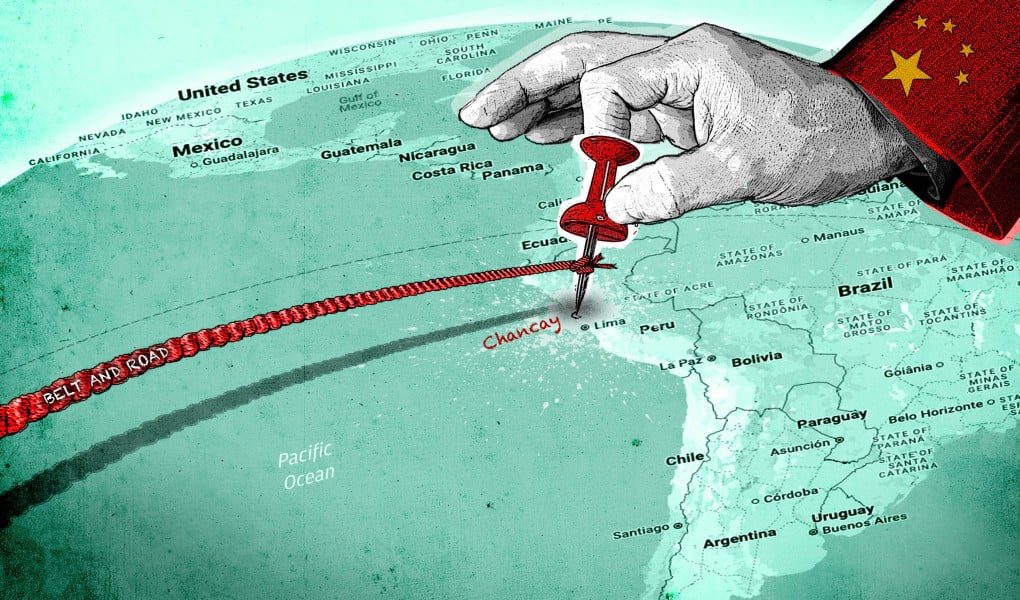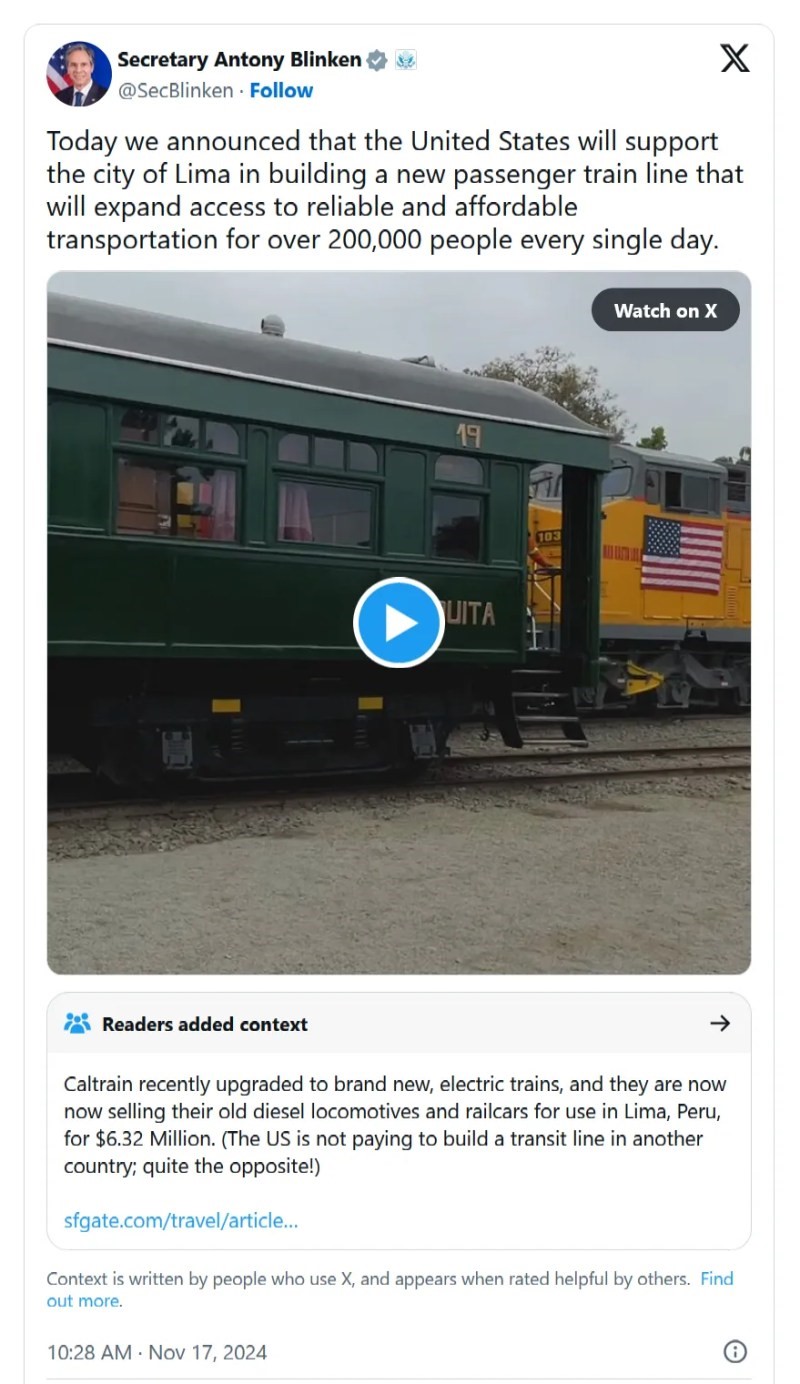China builds $3.5 billion megaport in Peru; US offers 40-year-old trains in response
US politicians complain about China’s growing influence in the world, but offer no alternatives to help countries develop. Beijing is building ports for $3.5 billion, while Washington is offering used trains from 1985
 China has invested billions of dollars in building a historic “megaport” in Peru that has the potential to transform trade in Latin America and boost regional economic development.
China has invested billions of dollars in building a historic “megaport” in Peru that has the potential to transform trade in Latin America and boost regional economic development.
The United States has demonized this port and portrayed it as a threat, but Washington has not offered Peru any alternatives.
Instead of helping Peru build a similar infrastructure project, the US government was only willing to sell the country used diesel trains from the 1980s.
To make matters worse, Joe Biden’s administration falsely told the public that it “donated” these 40-year-old trains, but in reality Lima had to pay millions of dollars.
Chinese President Xi Jinping traveled to Peru in November to attend the annual APEC summit, where he inaugurated the massive port of Chancay on Peru’s Pacific coast.
The port of Chancay will reduce transport time between Asia and Latin America from 35 to just 23 days and will also reduce costs by an estimated 20%.
$1.3 billion has already been invested in the project, and there are plans to further expand the port and build an industrial park at a total cost of $3.5 billion. Annual revenues are expected to reach $4.5 billion.
US alternative for Lima: used diesel trains from 1985
Washington has expressed outrage at the growing relations between China and Peru.
US Secretary of State Antony Blinken also traveled to the South American country in November, where he tried to steal the show from Xi by holding a press conference.
In front of 40-year-old trains bearing the U.S. flag, Blinken announced that the United States will support the city of Lima in “developing a new passenger rail line.”
The White House released a factsheet on “Promoting the Partnership between the United States and Peru,” in which the Biden administration wrote that “Caltrain, the California commuter railroad, will donate 90 passenger cars and 19 locomotives to the city of Lima.”
However, there was a big problem with this claim: it was false. The used trains were not a donation.
The local California press revealed that Caltrain sold the trains to Lima for $6.32 million after Caltrain replaced its old 1985-built diesel trains with a more modern electric fleet.
On X / Twitter, the video of Blinken’s Peru press conference was accompanied by a community note that challenged his misleading claims.

US media claim Peru is their colonial “backyard”; Trump adviser threatens tariffs
This incident was a striking symbol of the great differences between the foreign policies of China and the United States.
Instead of helping Peru develop its infrastructure, US officials have responded with threats against the South American country.
Mauricio Claver-Carone, a senior Latin America adviser to President-elect Donald Trump who served in his first term and is now supporting his transition team, indicated that the U.S. government would impose tariffs on 60% of goods passing through the port of Chancay.
Using colonial language, US media outlets such as Newsweek portrayed the Chinese-built port in Peru as a supposed threat “in America’s backyard.”
This condescending rhetoric is based on the 200-year-old colonial Monroe Doctrine, which top officials in the Trump administration are invoking to restore US imperial hegemony in the region.
Political leaders in Latin America have long emphasized that their countries are not the “backyard” or territory of a foreign power; they are sovereign, independent nations.
Moreover, Peru is not even geographically close to the United States. The distance between the U.S. capital, Washington, DC, and the Peruvian capital, Lima, is a whopping 5,700 kilometers (more than 3,500 miles).

The irony is that the US press demonises China, while Washington has long interfered in Peru’s internal affairs and violated its sovereignty.
In 2022, the United States supported a coup that overthrew the democratically elected leftist Peruvian President Pedro Castillo.
Peru’s current right-wing head of government, Dina Boluarte, was never elected and is so despised by her people that her approval rating is always in the single digits.
Boluarte has also proven to be extremely pro-American. However, China is Peru’s largest trading partner, accounting for 32% of its trade.
Moreover, this port has been planned for well over a decade. Construction began years before Boluarte took office and it would have been inaugurated regardless of the president’s identity.
The fact is that the port of Chancay has the potential to transform the country economically. Any Peruvian leader would have tried to take credit for it. Boluarte was just lucky that it occurred at a time when she could (undemocratically) seize power.
What this situation shows on a deeper level is that, despite the political sympathies of the ruling comprador elite, the United States is losing influence on the ground because it is not offering anything that would actually benefit the Peruvian economy.
Washington expects countries like Peru and their Westernized ruling classes to sacrifice their own economic interests in the name of the United States. Increasingly, however, even pro-US elites are no longer willing to do so because they have other options.
China’s state-led Belt and Road Initiative versus the BlackRock-funded G7 private infrastructure
China is already the largest trading partner of most South American countries.
New infrastructure projects in the region, such as the port of Chancay, will help Asia and Latin America deepen their economic integration, what Beijing calls South-South cooperation.
Bolivian President Luis Arce reported that he spoke with Chinese President Xi on the sidelines of the G20 summit in Brazil in November. They discussed plans for an interoceanic train connecting the Pacific and Atlantic, starting from the Peruvian port of Chancay via BRICS partners Bolivia and Brazil.
The megaport is an important part of what China calls the Maritime Silk Road of the 21st century.
Beijing sees the port of Chancay as a “showpiece project” of its Belt and Road Initiative (BRI), a decade-long campaign in which China has spent more than $1 trillion building infrastructure around the world.
With the BRI, China has sought to diversify its international economic relations and reduce its dependence on Western markets.
In 2011, the Barack Obama administration announced a “pivot to Asia” and planned to send more US troops to the Asia-Pacific region to militarily encircle China. Donald Trump’s administration started an aggressive trade war against China, which was further intensified by Joe Biden.
By building new infrastructure and trade networks in the global South, China hopes to reduce its dependence on trade with an increasingly hostile United States that seeks to contain it.
The projects under China’s BRI are mostly being built by state-owned enterprises (SOEs), which are not profit-making and can therefore invest in infrastructure that may not make much money but is strategically important. SOEs account for more than a third of the Chinese economy.
The port of Chancay was 60% financed by China’s state-owned company COSCO Shipping, while the other 40% was financed by a private Peruvian mining company.

While China has become a world leader in building high-quality infrastructure, the United States has failed to invest in basic infrastructure at home, where its own bridges are collapsing.
The Biden administration made a final attempt to compete with Beijing by announcing a G7 initiative called Build Back Better World (B3W). The US state-run propaganda ministry VOA bluntly called it Washington’s “equivalent to China’s Belt and Road.”
So far, however, B3W has had very little impact. One of the main reasons for this is that the G7 campaign does not rely on the state, as China did with the BRI, but on private, for-profit companies.
From the beginning, the US government has made it clear that B3W is a neoliberal campaign based on “public-private partnerships” in which Wall Street investment funds are supposed to generate returns for their wealthy clients by buying up privatized infrastructure.
The White House press release announcing the initiative stressed that “the G7 and other similar partners will coordinate on mobilizing private sector capital” and that B3W aims to “support and catalyze a significant increase in private capital to meet infrastructure needs” by relying on a “market-driven private sector.”
B3W was later renamed Partnership for Global Infrastructure and Investment (PGII).
At the G7 summit in Italy in June 2024, the White House announced that BlackRock will help oversee the PGII by mobilizing “private capital for projects” and leveraging the “private sector” to build infrastructure.
BlackRock is the largest investment firm in the world with $11.5 trillion in assets under management.
Billionaire oligarch and BlackRock CEO Larry Fink spoke as guest of honor at the G7 summit, where he stressed that “building new infrastructure is critical, especially through public-private partnerships.”
Fink outlined the plans of Wall Street investment firms to enrich their clients by building privatized infrastructure in the global South while sitting at a table with G7 leaders and explaining the strategy:
“The IMF and World Bank were founded 80 years ago, when banks, not markets, financed most things. Today, the financial world has changed. Capital markets are the main source of private sector financing, and unlocking that money requires a different approach than the bank balance sheet model of the past.
There is still a lot of work to be done, but the reforms of the last eight months have resulted in billions of dollars being poured into developing world infrastructure. You saw that with the announcement by the investor coalition. BlackRock, GIP [Global Infrastructure Partners], KKR and other major firms will invest $25 billion in emerging Asia.”
yogaesoteric
December 1, 2024
